Pastry Training Centre of Vancouver – Moulded Chocolates Class
Posted by Brenda Lowe on Saturday, November 13th, 2010Tags for this Article: Chocolate; Cooking Class; Pastry Chef; Marco Ropke
As pastry topics get more advanced, they can be difficult to execute successfully at home. This is where a cooking class can be the most efficient way to get from point A to B. While most classes targeted towards amateur cooks do a good job of covering the basics, few go into the level of detail that professional programs do. For those who’ve reached a certain point in their home cooking skills or who want to try a more advanced topic but don’t want, or aren’t able, to attend a professional program then the next best thing are shorter classes taught by professional chef instructors.
The Pastry Training Centre of Vancouver is the city’s newest cooking school, with classes on classic European pastries, breads, chocolate, and cake decoration. They are intended for enthusiastic home bakers or professionals interested in a particular pastry topic, with each full day or two half-days class focusing on a specific subject such as macarons, mousse cakes, or chocolate truffles. The majority of classes are taught by the chef-owner, Marco Ropke. A classically trained pastry chef, he started learning in his family’s shop at a young age and progressed through European apprenticeships all the way to executive pastry chef at a number of top end international hotels. He was the first pastry instructor at the Northwest Culinary Academy of Vancouver and worked there for a number of years. (See his full bio here.)
Class sizes are small (and vary depending on the subject) so there is a very good teacher to student ratio, and everything is hands-on. For larger sized classes, students may be paired up. Their most popular classes are bread, and macarons. Many of the classes come in a series, but they do not have to be taken sequentially and none are pre-requisites for anything else.
Making chocolates is probably one of the most challenging things to learn on your own. Not the refrigerated truffle kind, but the kind that involves tempering, hand-dipped centres, plastic moulds, transfer sheets. Thankfully, the pastry school has six (six!) classes on chocolate alone. I took the first one that my schedule allowed for, Chocolate Course 3 – Colourful Modern Moulded Pralines. In parts of Europe, the term ‘praline’ refers to filled chocolates in general, in addition to the nut/sugar definition that most are familiar with.
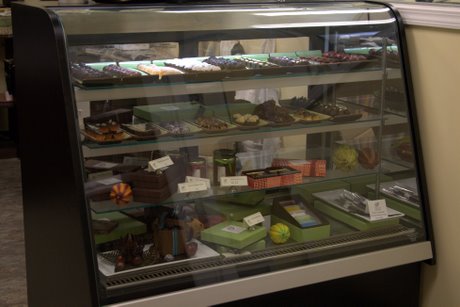
The front of the school has a retail showcase of chocolates from the different classes.
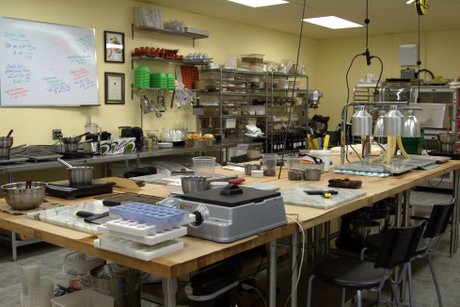
The classroom set up for Chocolate Course 3.
Moulded chocolates are made by pouring tempered chocolate into a hard polycarbonate plastic form to create shells, draining excess chocolate and allowing the shells to set, filling the shells with caramel or ganache, and then pouring more chocolate over the filling to seal them. The chocolates are left to set and harden in the moulds, and then released with a gentle rap on the counter. That’s the ideal scenario anyways. My prior attempts at home usually required more forceful encouragement, which can damage the chocolates. Sometimes they do not release at all; a result of improper tempering. When they are properly made, the chocolates are strikingly gorgeous and shiny.
Tasty as chocolate making mistakes can be, I was pretty eager to learn a better way. Things were off to a good start when I saw that we had to temper chocolate using the traditional marble slab method. (At most other places, a theoretical discussion is given or the students are given a brief demo by the instructor and then go off and use chocolate that has already been tempered by machine. That’s all fine and good until you go home and are faced with having to do it yourself.)
Interestingly, a thermometer wasn’t involved. As someone with a physical science background, this was the hardest preconception to get over. Everything was done by look and feel, checking the chocolate temperature against body temperature, and doing temper tests. By the end of the second day, I was much more confident in working without a thermometer. However, the ultimate test is in the unmolding of the chocolates.
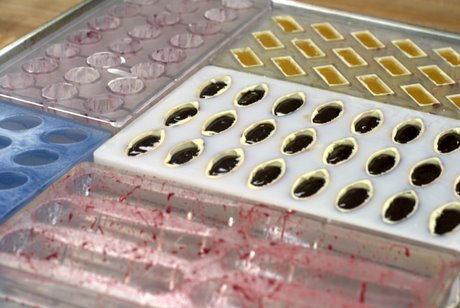
The first step in making coloured moulded chocolates is to decorate the moulds using coloured cocoa butter. The different methods we learned were air brushing (blue/white lower left), finger painting (purple/white upper left), flecks applied using a toothbrush (lower right).
In the photo above, the two upper right moulds already have been coloured, filled and drained with tempered white chocolate to create shells, and the shells filled with ganache.
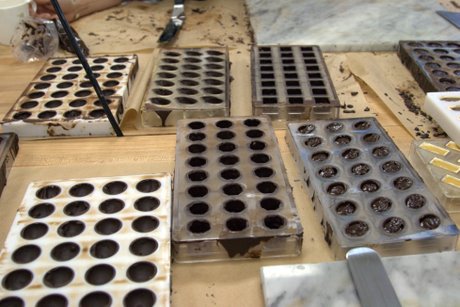
Additional moulds in various stages using tempered dark chocolate. Each student made 6 different types of chocolates, one type per mould.

Chef Marco’s finished chocolates.

Close up detail. The shine comes from the smooth plastic moulds and perfectly tempered chocolate.

Close up detail on two of my moulded chocolates. They released, yay!
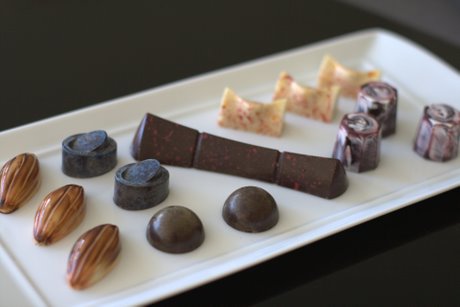
My six different types of chocolates.
Moulds come in a fantastic variety of form and design. Smooth, uniform and more shallow shapes (cocoa pod, hemisphere, wavey rectangle) release more easily than angular, irregular or deep shapes (slanted oval, baton, hexagonal cylinder).
Overall I was very happy with the end result, and I can’t wait to practice again at home. The only caveat would be that the course handouts seem to only cover recipes, not technique (which you can easily find in books and online), so be prepared to take notes. It doesn’t hurt to have some familiarity with the topic, and bringing a camera is a good idea.
Pastry Training Centre of Vancouver
818 Renfrew Street
Vancouver, BC
http://www.vancouverpastryschool.com/
Additional Resources
Chocolate moulds can be purchased online from Quebec at Chocolat Chocolat.
The Culinary Institute of America publishes two good books: Chocolates and Confections (geared more towards professionals but a great resource for amateurs) and Chocolate and Confections at Home (for home cooks).
In the class, we used Belcolade chocolate. It can be purchased from the Pastry Training Centre of Vancouver, or from Chocolate Works in Coquitlam (their retail store is open from Monday – Saturday).
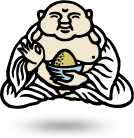

Posted on November 15th, 2010
Jules says:
Oh yum! I am looking forward to trying them ;)